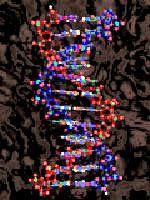DNA
and Solar Radiation
Biologist
Charles Darwin was one of the first to describe the evolutionary
process of one of natural selection, whereby the most capable flourish
at the expense of the weak. Later, it was found that genetic mutation,
exaggerated by selective breeding, was the facilitating prime mover
in the selection process. But Maurice Cotterell, author of The Mayan
Prophecies, Astrogenetics and several other cutting edge books
has studied the effects of solar radiation on humans for over twenty
years and discovered that genetic mutations are caused through the action
of ionising radiations. He has found that X-rays and gamma rays from
the Sun are the key factor in genetic leaps of species.
The DNA is spliced
which causes the genetic mutations. Ionising radiation and magnetic
radiation from solar flares on the Sun’s surface and other sources
have acted upon developing genera causing mutational leaps in species.
He also discovered that these periods of radiation cause people to become
more intelligent and make great advances in society. These claims are
mapped out in detail in The Mayan Prophecies. The sunspot cycles
are part of this mutational process. Cotterell found that the suns solar
flares peak in an 11.5-year, a 187-year, a 3,740-year and an 18,137-year
cycle, which increase in intensity on respective peaks. 1991 was the
peak of an 11.5-year cycle where sunspot activity was at an all time
high. It is theorized by many that the peak of all the cycles together
are destined to meet in December 2012.
He found that the Mayan calendar also uses the same cycles for recording
time, proving that they had advanced knowledge of the Sun even before
the invention of a telescope. In fact, the Mayans had such an advanced
knowledge of the Sun and the movement of the Galaxy; we are only just
starting to catch up now.

